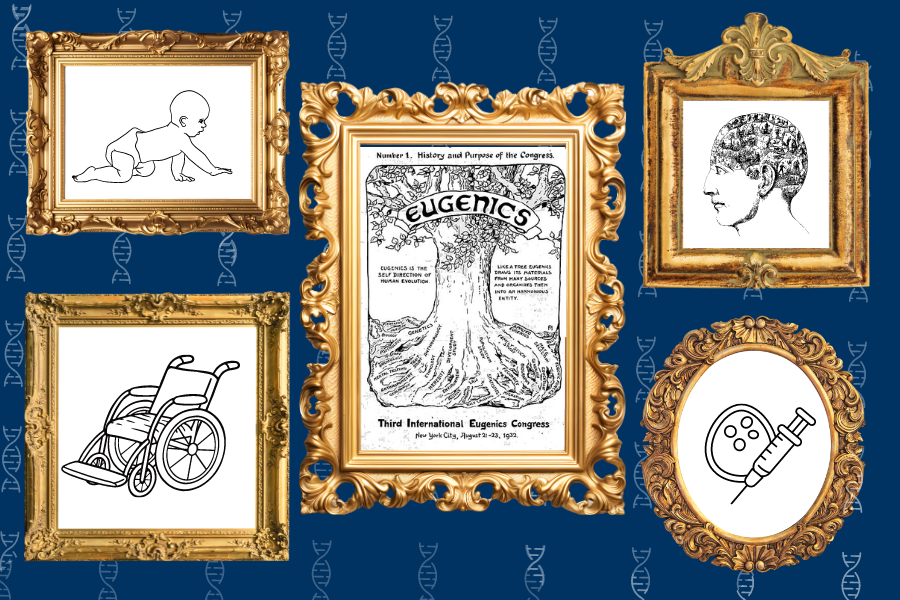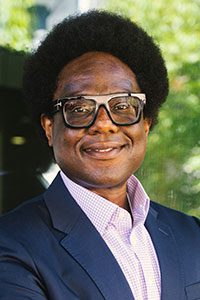The Legacy of Eugenics
Professor Osagie K. Obasogie launches landmark series with L.A. Review of Books

These days, it’s a rare scientist who would admit to working in eugenics.
The word conjures historical horrors: mass sterilization of people judged unfit to reproduce, state anti-miscegenation laws, and Germany’s justification for the Holocaust.

But to Osagie K. Obasogie, a professor of law and bioethics at UC Berkeley, the discredited theory that selective breeding can—and should—be used to improve the human race lives on in hidden but insidious ways. And he wants to bring those ideas in science and medicine out of hiding, in a national conversation that will prevent the repetition of the past.
“Few people today will call themselves eugenicists,” said Obasogie, Haas Distinguished Chair and professor of law; who also holds a joint appointment at the School of Public Health and the UC Berkeley/UCSF Joint Medical Program. “However, it’s not uncommon for mainstream scientists to embrace some of the ideas, ideologies and practices that would be imminently familiar to a eugenicist of the past.”
Reproductive technologies that purport to help parents select embryos with particular traits concerning, for example, hair or eye color, or create children who might excel at music or sports, might align with eugenic thinking in ways that people might not immediately realize, Obasogie says. He believes that such technology must be scrutinized from both a scientific and ethical perspective to avoid the terrible racism and classism that defined eugenics from its founding.
“This idea has been around for a very long time,” he said. “It’s been incredibly harmful and we have to maintain our historical commitment to resisting this way of thinking.”
Toward that end, Obasogie has teamed up with the Los Angeles Review of Books (LARB) to launch a two-year project called Legacies of Eugenics. It’s a national conversation on the history of eugenics and the ways it still shapes various aspects of science, medicine, and technology.
Experts from fields across the humanities, medicine, health and social sciences, and other disciplines will contribute a variety of eugenics-related essays to the series, which is supported by the Center for Genetics and Society, the Othering & Belonging Institute, and Nova Institute for Health, along with UC Berkeley School of Public Health. Articles in discussion will explore the entanglement of eugenics in statistics; the role of eugenics in the founding of Stanford University; and researchers’ quest for genes that are associated with high intelligence, among other topics.
Eugenics in California
In Obasogie’s introductory essay, published in April, he makes the case that eugenics thinking did not end in the last century, as many people believe.
“Eugenics stood for the idea that a person’s abilities and social position were innate traits determined by their biological and genetic makeup, and the same traits would be passed on to their children,” he wrote. “Everything from intelligence to poverty to criminality to general morality was thought to be inherited.
“In the late 19th century, when race science was all the rage, eugenics extended the conversation on scientific racism by providing not only a seemingly objective way to understand the achievements of wealthy whites across generations but also an explanation for why poor or disabled people and racial minorities seemed stuck, unable to break what appeared to be inescapable cycles of destitution. In short, biology was thought to be destiny.”
Social determinants like racism, classism, and environmental influences were not in the picture.
“State and institutional commitments to eugenics extended far beyond the end of World War II,” Obasogie wrote. “For example, California continued to sterilize some disabled and institutionalized people until 1979. And as recently as 2013, incarcerated women were routinely sterilized in California state prisons. Latin American women who gave birth at the Los Angeles County+USC Medical Center in the 1970s were coerced into sterilization, where victims recalled being ‘bullied by doctors and nurses who declared their children burdens on California taxpayers’
“There was even a so-called Nobel Prize sperm bank in Escondido, created by millionaire Robert Klark Graham in 1979. He hoped to create scores of purported superbabies. Graham convinced four Nobel laureates to contribute their sperm, including Stanford University professor William Shockley—inventor of the transistor—who was also an open racist and eugenicist in his own right. Shockley once said during a televised debate that his ‘research leads [him] inescapably to the opinion that the major cause of the American Negro’s intellectual and social deficits is hereditary and racially genetic in origin and thus not remediable to a major degree by practical improvements in the environment.’”
“From this vantage point,” Obasogie concluded, “eugenics is as Californian as palm trees, Hollywood, $2 million teardown houses, and $22 burritos.”
Startups and eugenics
Michele Pridmore-Brown, LARB’s science and technology editor, and a research scholar with UC Berkeley’s Center for Science, Technology, Medicine and Society, said she was immediately interested when Obasogie suggested they collaborate on the project.
“We hadn’t done this sort of thing before; it was totally new,” she said. “I had to do some convincing, but everybody was intrigued by the idea, especially since eugenics is still so relevant.”
Pridmore-Brown, who has herself written on eugenics, said she is wary of researchers seeking genes associated with high IQ, with an eye toward helping parents create smart babies.
“Startups are doing that sort of thing and it’s very dangerous,” she said. “It’s so short-sighted and blind. You might find particular genes associated with high IQ, and those same genes might also be associated with other traits— like, say, anxiety, allergies, and even lack of empathy—that may not be so good. Unfortunately the people in the business of doing this want to replicate themselves and their type of intelligence. It’s problematic.”
A eugenics fund at UC Berkeley
Obasogie’s focus on eugenics began in November, 2018, when an email that listed funding opportunities available at the UC Berkeley School of Public Health landed in his inbox. Among them was something Obasogie had never seen before: a call for research to be funded by the Genealogical Eugenics Institute Fund.
“I was stunned,” he recalled. “At first, this seemed like another benign funding email and then I read it and thought, ‘Wait a minute. Where did this fund come from? What is it?’ And no one really knew.”
Obasogie and other concerned faculty met with school administrators, who quickly suspended the fund. He learned that it came from a private trust which was developed “for the primary purpose of improvement of the human race through research and education in the field of eugenics.”
The fund had a circuitous path to the school. Established in 1960 as a private trust, it was later transferred to the UC Regents, then moved to UC Berkeley, where it ended up at the School of Public Health. The annual $70,000 payout had been used to fund student and faculty research unrelated to eugenics.
After a public apology, the school renamed the fund, and started using the money for projects to raise awareness about racism, disability discrimination and other forms of social bias in science and beyond—including Legacies of Eugenics.
Alexandra Minna Stern, UCLA’s dean of humanities, and a previous collaborator with Obasogie, has long studied sterilization and social justice. Stern, a professor with an appointment at UCLA’s Institute for Society and Genetics, also studies ecofascism: the distorted idea that environmental concerns such as climate change are caused by overpopulation, which far right advocates want to remedy by restricting immigration and limiting reproduction among minority groups.
The far right, she said, “is worried about the demographic composition of the country,” Stern said. “Who should have babies, and be let into the country with immigration policies.
“Ecofascism equates whiteness with purity and strength. I am working on an essay that addresses the new packaging of ecofascism in context of the emergency of the rise of the far right and how it perpetuates eugenic ideas.”
Another contributor, Jessica Riskin, the Frances and Charles Field Professor of History at Stanford, who studies evolutionary biology, is planning to write about the way in which eugenics is entwined in modern interpretation of Darwinism.
“Science is an element of culture, just like every other human endeavor,” Riskin said. “I think people think of it as if there is bad, corrupt, racist science and then there’s pure science. It just doesn’t work like that. You can’t separate science from culture; racism is built into the deep structure of biology.”
“The job of the series is to excavate the racism in the structure of science and reveal it, to think about it out in the open.”
Obasogie hopes this public conversation will spur more critical thinking about the increasingly popular mindset about engineering perfect babies.
“The idea that the traits society values or abhors are somehow all encoded at a genetic level that determines people’s behaviors and abilities is a bit of a stretch,” he said. “I think we need a deeper appreciation of the role that socialization and social groups play in helping people become the individuals that they are, and not necessarily reduce the attributes, good or bad, to some type of inherent genetic predisposition.”
“Eugenics transcends traditional left/right political divides. For example, just as some people on the far right embrace eugenics as a way to restrict immigration and reproduction among racial minorities, some on the progressive left find engineering perfect babies enticing. Others even go further in thinking that they—the smart and beautiful members of the elite—have a responsibility to have as many children as possible to repopulate the earth with their genes, or at least to not let those who are perceived as less capable out-reproduce those who are thought to be more talented. It’s a troubling mindset, and one that is not novel. We’ve seen this before, and this project is about making connections between certain ways of eugenic thinking when it’s largely believed that eugenics is a thing of the past.”
